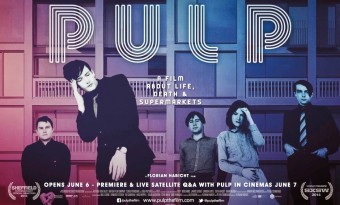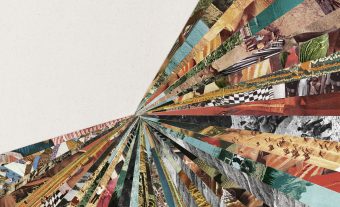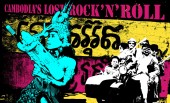If you happen to live above terra firma, you’re probably aware that a certain international football tournament kicks off tonight in Brazil. Whether you plan to spend the next month lapping it up in front of the box or trying to escape it by hiding under the duvet (it’s a 50/50 split at Monitors HQ), it has meant one of the most fascinating and complicated countries in the world has, as host nation, been under intense scrutiny. In a climate of protest and corruption, the 2014 World Cup is likely to dominate front pages as well as back pages this summer, but then, as we argued in our piece on Brazilian hip-hop earlier this year, there’s always been much more to Brazil than football anyway.
You won’t find this illustrated any better than it is in a new book about Brazilian culture by the South American music and culture magazine Sounds and Colours. Casting an expert eye over the music, film, art and literature of the country, it’s a hugely engrossing read, covering everything from street art to technobrega via about a dozen genres you’ve never heard of. Frankly, it’s the best way to immerse yourself in what the locals listen to, read and watch without actually going there yourself. Described as “a great read” by none other than Gilles Peterson (and he would know), it also comes with a 20-track CD so you can hear some of the authors’ choice selections yourself. Fantástico!
We’re happy to announce we’ve been gifted two copies of the book and CD to give away to a couple of lucky readers. Simply head to this page to enter, or retweet this tweet (and follow us), and we’ll announce the winners at the end of the World Cup. Until then, get a taste of it by reading the opening chapter right here, written by the book’s editor Russell Slater. Think Rio de Janeiro is all Copacabana and Carnival? Think again…
“The samba is there [in Rio], it’s inescapable, but it doesn’t reign supreme, at least in the alternative universe.” – Otaner, La Cumbuca
There was a time when Rio ruled the roost. It was the nation’s capital, home to the big television networks, the movie industry and the major record labels. It was the birthplace of samba and bossa nova, and the destination for any new musician looking to make it, arriving to join those who already had. Its Carnival was the biggest and brightest; a glorious showcase of what being Brazilian was all about. In short, it was the cultural and entertainment hub of the country. These days São Paulo has taken that crown – it’s the new destination for aspiring artists, musicians and filmmakers – and you could argue that the increasing popularity of Carnivals in Salvador and Recife are even taking away its status as the first choice destination for those wanting to experience that most fabled of Brazilian parties.
Today, Rio is a city with an identity crisis. Its image – beaches, great architecture, easygoing lifestyle and the redemptive glare of Christ looking over the whole thing – is great for tourism (surely São Paulo will never take away that crown) but the samba and bossa nova that’s so often associated with that image no longer takes centre stage. In underground clubs and record shops, on the streets during Carnival and in recording studios up and down the city there’s a new generation of musicians going beyond the picture postcards to reveal that this city’s image is more multi-dimensional than it’s often given credit for.
One common saying about Rio is that once you pass through the tunnels from the plush surroundings of Copacabana, Urca and Ipanema in the city’s South Zone, passing under the hills and ending up in the working-class neighbourhoods of the North, it’s like entering another world; and so it is with music. Head through the tunnels passing from samba, Carnival and bossa nova and you’ll find a surprisingly diverse alternative music scene in Rio, full of brass bands, experimental noise and rockers trying to find that carioca groove.
The neighbourhood of Lapa, a short walk from Rio’s financial centre, is the throbbing heart of Rio’s party culture. Come nightfall the streets around Lapa’s famous arches are packed with people, there to drink caipirinhas and experience the carnivalesque atmosphere. The neighbourhood is known best for its atmospheric botecos, its impromptu samba jams, and its many dance clubs. Yet just just five minutes walk from the arches, tucked up a side street, is Plano B, a record store that has become a hub for Rio’s new experimental music scene.
Felipe, of the group Chinese Cookie Poets, a cornerstone of the scene, describes Plano B as “a five square metre hot oven.” In 2004, in cramped surroundings, the shop started organising improvisation sessions every Friday night. Attendance was often confined to just a handful of people, but the simple fact that Rio’s avant-garde musicians had a place to meet had a big effect. According to Felipe, genres from free jazz and avant pop to IDM and noise rock co-mingled at the sessions. “Just by being there and seeing other people sharing the same musical interests was like discovering the lost island,” says Felipe.
Slowly word got out and a network of open-minded musicians began to coalesce around the shop, which also began featuring international touring artists. In 2011, a new night called Quintavant started in Botafogo’s Audio Rebel club and splintered into an additional venue at Comuna (also in Botafogo). This meant that the scene finally had venues that could accommodate a full band, something which was never possible at Plano B. This move from mostly electronic gigs at Plano B to full bands at Quintavant is one of the reasons why this scene is so diverse. The range of styles includes the heavy doom of Bemônio, Chinese Cookie Poets’ arrhythmic rock, Duplexx’s glitchy IDM, Sobre A Máquina’s Throbbing Gristle-esque noise assault and the tropicália-tinted improv of Negro Leo. This is a scene united by a spirit of experimentation.
The scene was galvanised further by the emergence of Novas Frequências in 2011, an avant-garde music festival set-up by Chico Dub. The festival increased the profile of the movement and helped grow networks between likeminded Brazilian and international musicians. In the notes accompanying Chico Dub’s compilation Hy Brazil Vol 2: New Experimental Music From Brazil 2013, he writes that “Sobre A Máquina, Bemônio, DEDO and Chinese Cookie Poets [who all featured on the compilation] are part of something very exciting that has been happening lately in Rio de Janeiro.”
Despite the lack of venues in Rio for the scene and the relatively small audience – the Quintavant nights pull in up to 200 people, a good amount though not much for a city the size of Rio – the scene has been able to grow via attention garnered on the internet. Releases by Bemônio, Chinese Cookie Poets and Sobre a Máquina all featured on the “Best of 2012” lists of many well-respected journalists and bloggers. O Globo picked up on the scene in late 2012, with journalist Silvio Essinger declaring that “the musical vanguard is gaining force in Rio”, citing “the consolidation of venues, regular visits by international names, a growing interaction between the musicians and internet buzz” as reasons for this success.
While the experimental scene in Rio works on finding space for its sonic adventures, another group of bands are feeding off Rio’s carnival traditions and bringing a new audience to the city’s famous blocos. Brass bands are popping up all over the world – CQMD in France, the Youngblood Brass Band in the US and Hackney Colliery Band in the UK are just a few examples – and nowhere in Brazil is this trend getting more love than in Rio. Taking the name fanfarra from the European tradition of fanfare groups, Rio’s bands are orchestras of brass and percussion that are primarily assembled to make music on the street. This is exactly where Orquestra Voadora, one of the break-out successes of the scene, started out. The group began as a Carnival bloco in 2008, differentiating themselves from typical groups not just by their instrumentation but also by their repertoire, which would feature covers of international pop songs alongside classic sambas and marchinhas.
Orquestra Voadora “Ao Vivo Em Montmarte” (a 20-minute short film well worth watching)
Such was the popularity of the Orquestra Voadora blocos that by 2012 they were able to pull in an audience of 80,000 for their main carnival show. They also toured Europe that same year, and in 2013 released their first album Ferro Velho, which features covers of Fela Kuti, Stevie Wonder and Rage Against the Machine alongside songs from the Brazilian music canon. By freeing up their repertoire to include pop songs and by offering a different sound, Orquestra Voadora has been able to offer an alternative Carnival experience for young cariocas, and it certainly seems to be catching on. Other fanfarra groups in the city include Cinebloco, who interpret music from film soundtracks, Os Siderais, Go East Orkestar and Sinfônica Ambulante, from nearby Niteroi.
For these bands, samba is just one of the musical foundations, alongside rock, funk afrobeat and forró. This trend for big bands that appeal to a modern audience could be seen as starting with Orquestra Imperial, a carioca group that started life in 2002 with the idea of creating an old-school samba de gafieira (ballroom samba) orchestra, but featuring musicians and singers from the Rio pop scene. Some of the artists who have collaborated with the group include Seu Jorge, Ed Motta, Elza Soares and Fernanda Abreu. But when former Los Hermanos singer Rodrigo Amarante became a regular member, the group really began to attract a strong indie audience. They’ve since released two albums (2007’s Carnaval Só Ano Que Vem and 2012’s Fazendo As Pazes Com o Swing) which both focus on carnival-ready samba, though with the variations and occasional experimentation you’d expect from such a diverse range of collaborators.
The Orquestra Imperial was created by Alexandre Kassin and Berna Ceppas, two musicians who helped define a new alternative rock/pop scene in Rio since the 90s that has continued to this day. Kassin’s group at the time, Acabou La Tequila, as well as Mulheres Que Dizem Sim, were two bands who, alongside São Paulo’s Los Hermanos, created a new fusion of rock and pop with a certain Brazilian swing.
“In Rio it’s the unique way you divide the tempo, it’s the city’s groove. Everyone has it inside their head,” is how Kassin described this swing in a recent interview. Kassin has produced and played on countless records that contain this particular carioca groove. Together with Moreno Veloso and Domenico Lancelotti, Kassin released three albums for the US record label Luaka Bop. It was known as the “+2 Trilogy” because each album would focus on the songs of one of the musicians with the other two as backing band, leading to the titles of Kassin +2, Moreno +2 and Domenico +2. Recently Kassin has been playing in Jorge Mautner’s band, creating a link to the older tropicália generation, as well as getting involved in diverse projects such as scoring the anime cartoon Michiko to Hatchin, producing major stars like Vanessa da Mata and Mallu Magalhães, and finally releasing his first solo record in 2011, Sonhando Devagar. Lancelotti has also been busy with many projects, such as Taksi, a recent collaboration with João Brasil which promises to fuse electronic and pop music in all the right places.
Caetano Veloso dipped into this talent pool for three of his most recent records, 2006’s Cê, 2009’s Zii e Zie and 2012’s Abraçaço. Searching for a more experimental sound, Caetano reached out to his son, Moreno Veloso, for help. Moreno recommended some of his friends as up for the task of offering a new, angular setting for Caetano’s music. The group, who became known as Banda Cê, includes Pedro Sá on guitar, Ricardo Dias Gomes on bass and Marcelo Callardo on drums, the last two of which are both members of Do Amor, a younger band who have also become a big part of this scene.
Moreno is not the only famous son to earn success of his own in Rio these days. Bem Gil, son of Gilberto, has a group called Tono who caused a ripple in 2010 thanks to their song “Samba do Blackberry”, an upbeat number that took the samba cliché of lamenting a lost lover for inspiration. Here the protagonist wasn’t losing his lover to another man, but to her new Blackberry. The song ends with the payoff line: “Ela me trocara por um Blackberry” (“She exchanged me for a Blackberry”).
The Rio rock/pop sound, infused with what Kassin called the “city’s groove” and which could be translated as a certain joie-de-vivre, is all over the music of Tono. It’s also present in the similarly upbeat Fino Colectivo and Alvinho Lancelotti’s excellent 2012 album O Tempo Faz a Gente Ter Esses Encantos. You could also argue that it’s present in the folkier sounds of Cicero (for fans of Beirut) or the layered electronic excursions of SILVA, an artist originally from the state of Espirito Santo but now making a name for himself in Rio.
Rio is a complicated place – it’s the capital that’s not a capital, a city renowned both for friendliness and violence, and so on – and this applies to the music too. Ricardo Dias Gomes, of Do Amor and Caetano Veloso’s Banda Cê, says that “in Rio, people don’t define themselves by a style but have an open mind to experiment.” That sentiment is backed up by Otaner, from the excellent Rio-focused blog La Cumbuca: “It’s not possible to say that there exists a ‘musical scene’ in Rio, because this would mean that there existed a group of artists that all shared the same characteristics.”
It’s true. Though historically Rio’s musical identity has been easily summed up the homegrown genres of samba, bossa nova and, more recently, funk carioca, its current musical output is almost impossible to pin down. Aside from the bands and trends identified above, there are Rio artists such as these, who don’t fit into any scene:
BNegão’s fusions of hip-hop, Afro-Brazilian music and rock; Lê Almeida’s Pavement-fawning garage rock; the tropical pop experiments of Gabriel Muzak; Digital Dubs’s reggae soundsystem parties; Dorgas’ pyschedelic musings, US expat Maga Bo’s rhythmic tropical bass; the hard electronic beats of Leo Justi and his more eclectic compadre Omulu; the alternative hip-hop of Cartel MCs, DJ Saddam and DJ Erik Skratch; and the undefinable Wladimir Gasper, who we are sure you’ll be hearing a lot more from in the future.
There’s no doubt that when you visit Rio you can easily find a club playing samba, a bar flowing with bossa nova melodies or even a party in the hills playing the hardest of funk carioca beats (you could even hear some saccharine pop/baile funk crossover fare in the clubs of Ipanema if you want). But if you dig a little deeper, there is a rich and diverse alternative scene that shows Rio for the cosmopolitan, hyper-social city that it is. Just follow the grooves, winding through the city much like its twisting tunnels, and you’ll find there’s something for everyone.
Russell Slater






Follow us
Follow us on Facebook Follow us on Twitter Follow us on Google+ Subscribe our newsletter Add us to your feeds